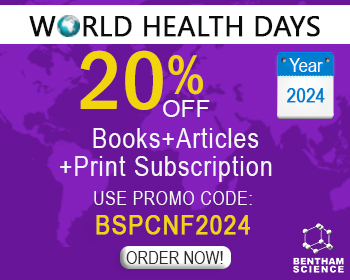Abstract
Infectious diseases, instigated by pathogenic microorganisms are the cause of numerous health problems in developing countries. Infectious diseases got a place in the list of top ten death causes worldwide. The reason behind that level of severity is antimicrobial resistance. Antimicrobial resistance makes the antimicrobial agents useless when used in the treatment of infectious diseases. Microbes have very smartly achieved resistance against synthetic and semi-synthetic antimicrobial agents for their survival. Therefore, the handling of these diseases has become challenging. The resistance developing power is the reason for their existence since a million years. Due to their highly dangerous nature, proper treatment of infectious diseases has become a topic of concern. This leads the scientists or researchers to focus their research towards natural agents. Plants synthesize secondary metabolites to cope up with biotic and abiotic changes in the environment. Alkaloids are one of the secondary metabolites, synthesized by plants. Alkaloids protect the plant from predators and help them to fight with pathogens. The protecting nature of alkaloids can be used as a strong weapon in battle with resistant microorganisms. The purpose of this review is to provide information about the antimicrobial activity of alkaloids obtained from different plants and their combination with synthetic antimicrobials. Their mechanism of action against microorganisms is also given in the review.
Keywords: Antimicrobials, alkaloids, inhibition, mechanisms, microbes, semi-synthetic.
[http://dx.doi.org/10.9790/3008-0424257]
[http://dx.doi.org/10.1093/jac/dks261] [PMID: 22782487]
[http://dx.doi.org/10.3109/13880209.2010.519390] [PMID: 21391841]
[http://dx.doi.org/10.1146/annurev-arplant-042110-103854] [PMID: 22404468]
[http://dx.doi.org/10.1016/0378-8741(95)01226-4] [PMID: 7475121]
[http://dx.doi.org/10.1016/j.jep.2017.07.011] [PMID: 28694104]
[http://dx.doi.org/10.1038/ja.2005.1] [PMID: 15813176]
[http://dx.doi.org/10.1016/j.jep.2006.04.015] [PMID: 16730420]
[http://dx.doi.org/10.1007/978-1-4757-2905-4_17]
[http://dx.doi.org/10.1111/j.1574-6976.2006.00024.x] [PMID: 16911039]
[http://dx.doi.org/10.1038/ja.2008.16] [PMID: 19132062]
[http://dx.doi.org/10.3390/plants6020016] [PMID: 28394295]
[http://dx.doi.org/10.1172/JCI18535] [PMID: 12727914]
[http://dx.doi.org/10.1371/journal.pmed.1002344] [PMID: 28686231]
[http://dx.doi.org/10.1128/MMBR.00016-10] [PMID: 20805405]
[http://dx.doi.org/10.1007/s00134-017-4878-x] [PMID: 28733718]
[http://dx.doi.org/10.1016/j.addr.2005.04.002] [PMID: 15950313]
[http://dx.doi.org/10.2165/00003495-200363040-00002] [PMID: 12558458]
[http://dx.doi.org/10.1172/JCI111042] [PMID: 6411768]
[http://dx.doi.org/10.1128/AAC.42.6.1493] [PMID: 9624500]
[http://dx.doi.org/10.1086/514920]
[http://dx.doi.org/10.1086/338782] [PMID: 11823954]
[http://dx.doi.org/10.1016/j.ajic.2006.05.219] [PMID: 16813980]
[http://dx.doi.org/10.1177/0885066615619895] [PMID: 26772199]
[PMID: 1316862]
[http://dx.doi.org/10.3389/fmicb.2010.00134] [PMID: 21687759]
[http://dx.doi.org/10.1016/S1473-3099(15)00466-1] [PMID: 26795692]
[PMID: 18171378]
[http://dx.doi.org/10.1016/j.tibtech.2006.03.003] [PMID: 16567009]
[http://dx.doi.org/10.1007/978-1-59259-976-9_1]
[http://dx.doi.org/10.1128/CMR.12.4.564] [PMID: 10515903]
[http://dx.doi.org/10.1039/c005378c] [PMID: 20730220]
[http://dx.doi.org/10.1007/978-94-007-6464-4_2]
[http://dx.doi.org/10.5897/AJB07.613]
[http://dx.doi.org/10.1016/j.ijantimicag.2014.06.001] [PMID: 25130096]
[http://dx.doi.org/10.1146/annurev.arplant.52.1.29] [PMID: 11337391]
[http://dx.doi.org/10.1007/978-94-011-2376-1_10]
[http://dx.doi.org/10.1039/a705715f] [PMID: 10584334]
[http://dx.doi.org/10.1007/s00114-008-0374-z] [PMID: 18392795]
[http://dx.doi.org/10.1007/s00049-012-0112-z] [PMID: 22904605]
[http://dx.doi.org/10.1039/b006897g] [PMID: 11245399]
[http://dx.doi.org/10.1023/A:1022315802264]
[http://dx.doi.org/10.1002/jlac.197919790815]
[http://dx.doi.org/10.1021/np900580f] [PMID: 19938815]
[http://dx.doi.org/10.1186/1475-2875-12-449] [PMID: 24330395]
[http://dx.doi.org/10.3390/molecules201018923] [PMID: 26501254]
[http://dx.doi.org/10.5530/pj.2017.4.91]
[http://dx.doi.org/10.1093/jac/dkq213] [PMID: 20551217]
[http://dx.doi.org/10.1080/13102818.2016.1209087]
[http://dx.doi.org/10.1021/bi050767+] [PMID: 16342949]
[http://dx.doi.org/10.25135/rnp.41.17.09.058]
[http://dx.doi.org/10.1021/bi7018546] [PMID: 18275156]
[http://dx.doi.org/10.1089/jmf.2005.8.454] [PMID: 16379555]
[http://dx.doi.org/10.1073/pnas.030540597] [PMID: 10677479]
[http://dx.doi.org/10.3389/fmicb.2012.00130] [PMID: 22536197]
[PMID: 8098708]
[http://dx.doi.org/10.3390/md7040705] [PMID: 20098608]
[http://dx.doi.org/10.3390/md16010009] [PMID: 29301295]
[http://dx.doi.org/10.1177/1934578X1200700917] [PMID: 23074900]
[http://dx.doi.org/10.1371/journal.pone.0112093] [PMID: 25391152]
[http://dx.doi.org/10.3923/ajps.2004.177.180]
[http://dx.doi.org/10.1007/BF02873586] [PMID: 11501395]
[http://dx.doi.org/10.1002/ptr.1517] [PMID: 15476315]
[http://dx.doi.org/10.1055/s-0028-1088344] [PMID: 18991207]
[http://dx.doi.org/10.1002/jps.2600640512] [PMID: 807704]
[http://dx.doi.org/10.1016/S0031-9422(01)00382-X] [PMID: 11738420]
[http://dx.doi.org/10.1007/BF02253574] [PMID: 11725078]
[http://dx.doi.org/10.1128/AAC.39.2.484] [PMID: 7537029]
[http://dx.doi.org/10.1016/j.jep.2005.04.025] [PMID: 15964727]
[http://dx.doi.org/10.1021/jm00038a003] [PMID: 8021914]
[http://dx.doi.org/10.1021/jf0259361] [PMID: 12568545]
[http://dx.doi.org/10.1016/S1995-7645(13)60040-1] [PMID: 23608375]
[http://dx.doi.org/10.1016/S0031-9422(00)95304-4]
[http://dx.doi.org/10.1002/jps.2600830327] [PMID: 8207690]
[http://dx.doi.org/10.1590/S0100-879X2006000300009] [PMID: 16501818]
[http://dx.doi.org/10.1016/S0031-9422(00)83488-3]
[http://dx.doi.org/10.1016/0031-9422(90)80209-Y]
[http://dx.doi.org/10.1021/np050095o] [PMID: 16038551]
[http://dx.doi.org/10.1021/np010298m] [PMID: 11975502]
[http://dx.doi.org/10.1016/j.phytochem.2005.05.001] [PMID: 15955541]
[http://dx.doi.org/10.1016/0031-9422(94)00666-H] [PMID: 7766168]
[http://dx.doi.org/10.1021/jf9805808] [PMID: 10563914]
[http://dx.doi.org/10.1016/j.jep.2012.01.037] [PMID: 22322252]
[http://dx.doi.org/10.1016/S0031-9422(01)00277-1] [PMID: 11557080]
[http://dx.doi.org/10.1021/np50104a018]
[http://dx.doi.org/10.1021/np000012y] [PMID: 10924184]
[http://dx.doi.org/10.1016/j.fitote.2010.04.004] [PMID: 20398742]
[http://dx.doi.org/10.1128/AAC.44.6.1645-1649.2000] [PMID: 10817722]
[http://dx.doi.org/10.1055/s-2007-971494] [PMID: 7312985]
[http://dx.doi.org/10.1021/np50073a012] [PMID: 1710653]
[http://dx.doi.org/10.1016/S0378-8741(98)00182-2] [PMID: 10433482]
[http://dx.doi.org/10.1016/S0031-9422(00)00402-7] [PMID: 11324918]
[http://dx.doi.org/10.18433/J3D30Q] [PMID: 19183517]
[http://dx.doi.org/10.1055/s-2003-38883] [PMID: 12709903]
[http://dx.doi.org/10.1016/j.phytol.2008.12.006]
[http://dx.doi.org/10.1021/np50088a001]
[http://dx.doi.org/10.1021/np50039a008] [PMID: 4031898]
[http://dx.doi.org/10.1016/j.bmcl.2012.02.053] [PMID: 22418278]
[http://dx.doi.org/10.1038/ja.2016.15] [PMID: 26932407]
[http://dx.doi.org/10.1111/cbdd.12103] [PMID: 23290001]
[http://dx.doi.org/10.3390/molecules16129819] [PMID: 22117171]
[http://dx.doi.org/10.1111/jphp.12326] [PMID: 25495516]
[http://dx.doi.org/10.1016/j.micres.2009.11.009] [PMID: 20116229]
[http://dx.doi.org/10.1016/j.phytochem.2007.09.006] [PMID: 17950385]
[http://dx.doi.org/10.1017/S0953756205002820] [PMID: 16018316]
[http://dx.doi.org/10.1021/jo000307g] [PMID: 11052082]
[http://dx.doi.org/10.1055/s-0031-1280124] [PMID: 21870325]
[http://dx.doi.org/10.3390/antibiotics7040098] [PMID: 30423994]





























